Homo Erectus in Asia: Anatomical Structure, Discovery, and Replacement
VerifiedAdded on 2023/04/11
|16
|2797
|299
AI Summary
This article explores the anatomical structure, discovery, and replacement of Homo Erectus in Asia. It discusses their evolution, migration patterns, and the fossils found in China and Indonesia. Discover the unique features of Homo Erectus and their role in human evolution.
Contribute Materials
Your contribution can guide someone’s learning journey. Share your
documents today.
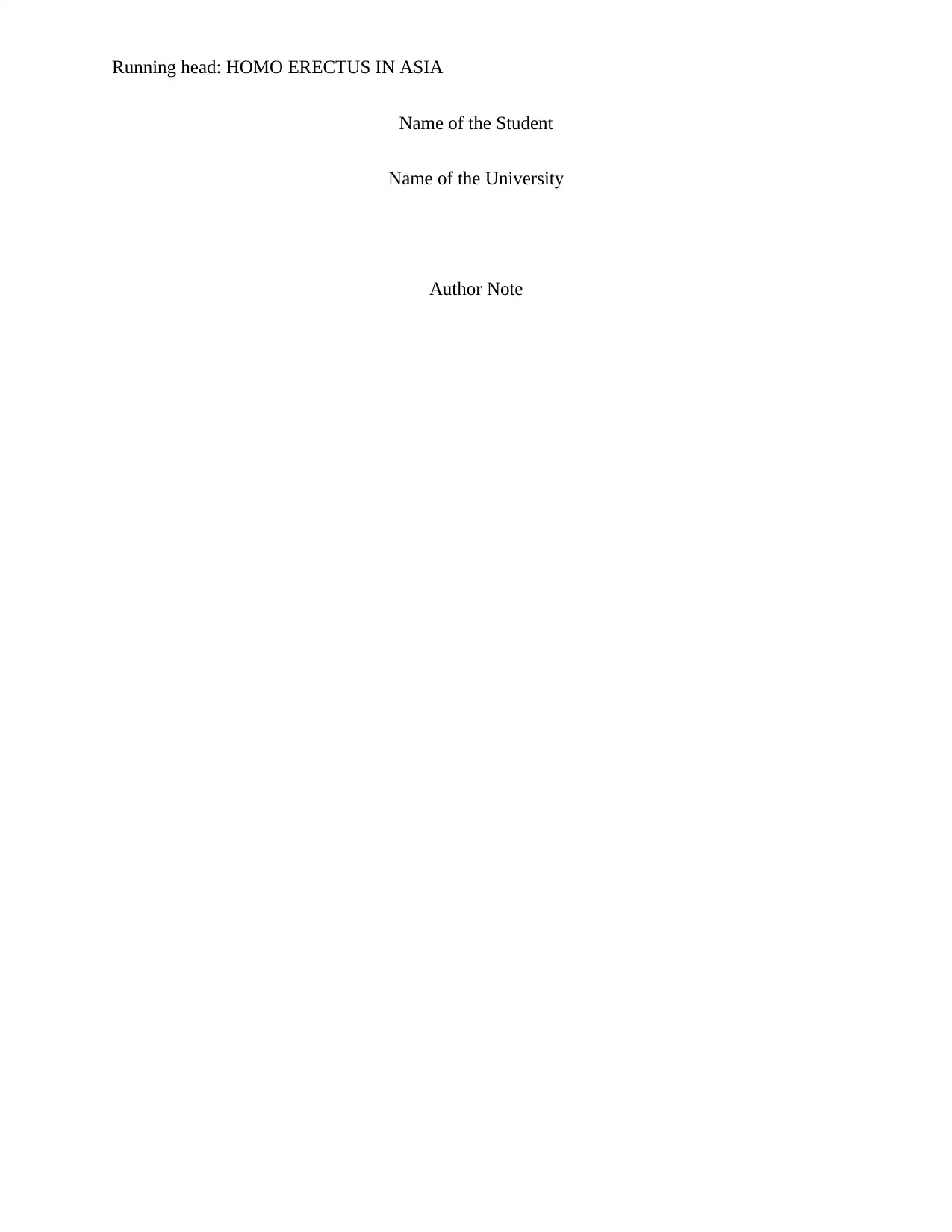
Running head: HOMO ERECTUS IN ASIA
Name of the Student
Name of the University
Author Note
Name of the Student
Name of the University
Author Note
Secure Best Marks with AI Grader
Need help grading? Try our AI Grader for instant feedback on your assignments.
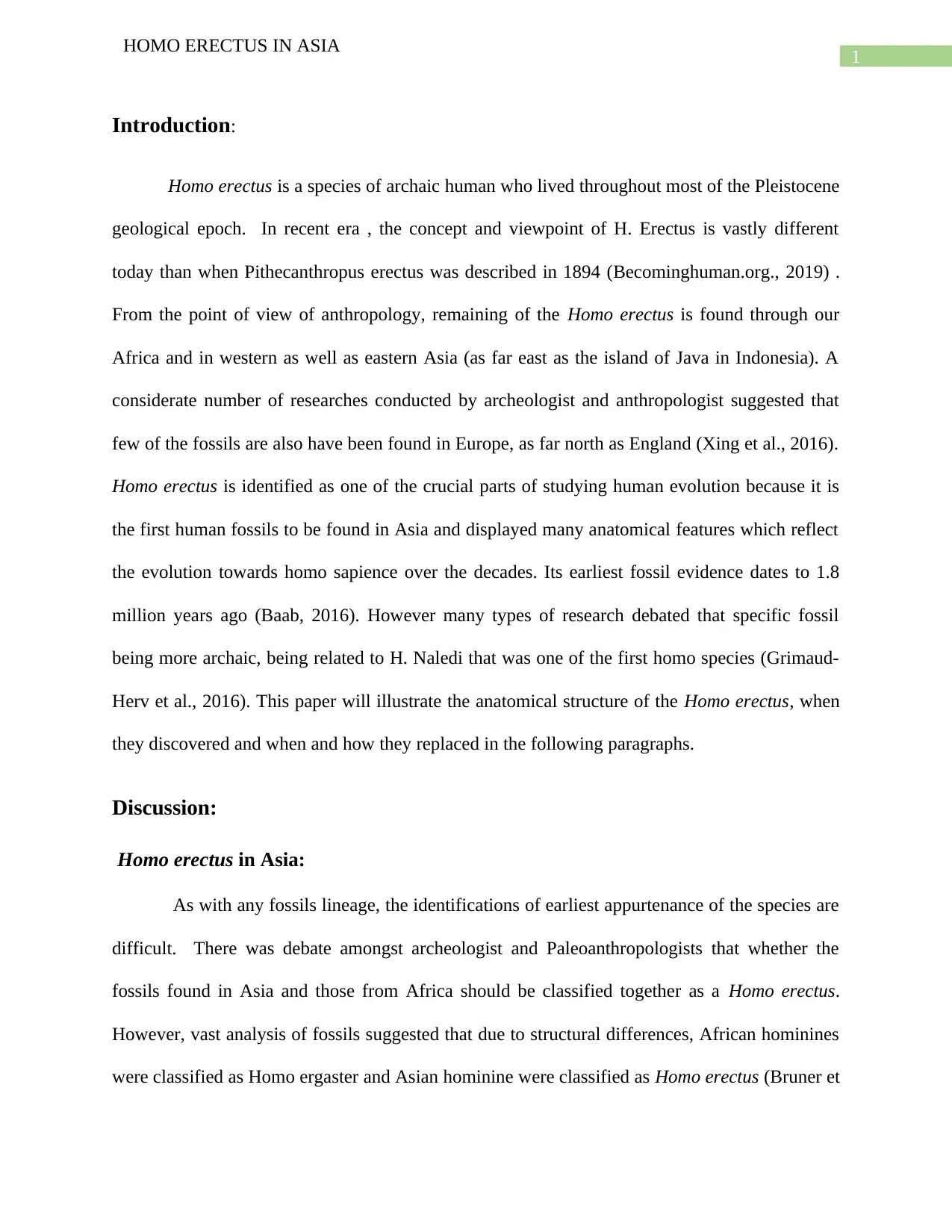
1
HOMO ERECTUS IN ASIA
Introduction:
Homo erectus is a species of archaic human who lived throughout most of the Pleistocene
geological epoch. In recent era , the concept and viewpoint of H. Erectus is vastly different
today than when Pithecanthropus erectus was described in 1894 (Becominghuman.org., 2019) .
From the point of view of anthropology, remaining of the Homo erectus is found through our
Africa and in western as well as eastern Asia (as far east as the island of Java in Indonesia). A
considerate number of researches conducted by archeologist and anthropologist suggested that
few of the fossils are also have been found in Europe, as far north as England (Xing et al., 2016).
Homo erectus is identified as one of the crucial parts of studying human evolution because it is
the first human fossils to be found in Asia and displayed many anatomical features which reflect
the evolution towards homo sapience over the decades. Its earliest fossil evidence dates to 1.8
million years ago (Baab, 2016). However many types of research debated that specific fossil
being more archaic, being related to H. Naledi that was one of the first homo species (Grimaud-
Herv et al., 2016). This paper will illustrate the anatomical structure of the Homo erectus, when
they discovered and when and how they replaced in the following paragraphs.
Discussion:
Homo erectus in Asia:
As with any fossils lineage, the identifications of earliest appurtenance of the species are
difficult. There was debate amongst archeologist and Paleoanthropologists that whether the
fossils found in Asia and those from Africa should be classified together as a Homo erectus.
However, vast analysis of fossils suggested that due to structural differences, African hominines
were classified as Homo ergaster and Asian hominine were classified as Homo erectus (Bruner et
HOMO ERECTUS IN ASIA
Introduction:
Homo erectus is a species of archaic human who lived throughout most of the Pleistocene
geological epoch. In recent era , the concept and viewpoint of H. Erectus is vastly different
today than when Pithecanthropus erectus was described in 1894 (Becominghuman.org., 2019) .
From the point of view of anthropology, remaining of the Homo erectus is found through our
Africa and in western as well as eastern Asia (as far east as the island of Java in Indonesia). A
considerate number of researches conducted by archeologist and anthropologist suggested that
few of the fossils are also have been found in Europe, as far north as England (Xing et al., 2016).
Homo erectus is identified as one of the crucial parts of studying human evolution because it is
the first human fossils to be found in Asia and displayed many anatomical features which reflect
the evolution towards homo sapience over the decades. Its earliest fossil evidence dates to 1.8
million years ago (Baab, 2016). However many types of research debated that specific fossil
being more archaic, being related to H. Naledi that was one of the first homo species (Grimaud-
Herv et al., 2016). This paper will illustrate the anatomical structure of the Homo erectus, when
they discovered and when and how they replaced in the following paragraphs.
Discussion:
Homo erectus in Asia:
As with any fossils lineage, the identifications of earliest appurtenance of the species are
difficult. There was debate amongst archeologist and Paleoanthropologists that whether the
fossils found in Asia and those from Africa should be classified together as a Homo erectus.
However, vast analysis of fossils suggested that due to structural differences, African hominines
were classified as Homo ergaster and Asian hominine were classified as Homo erectus (Bruner et
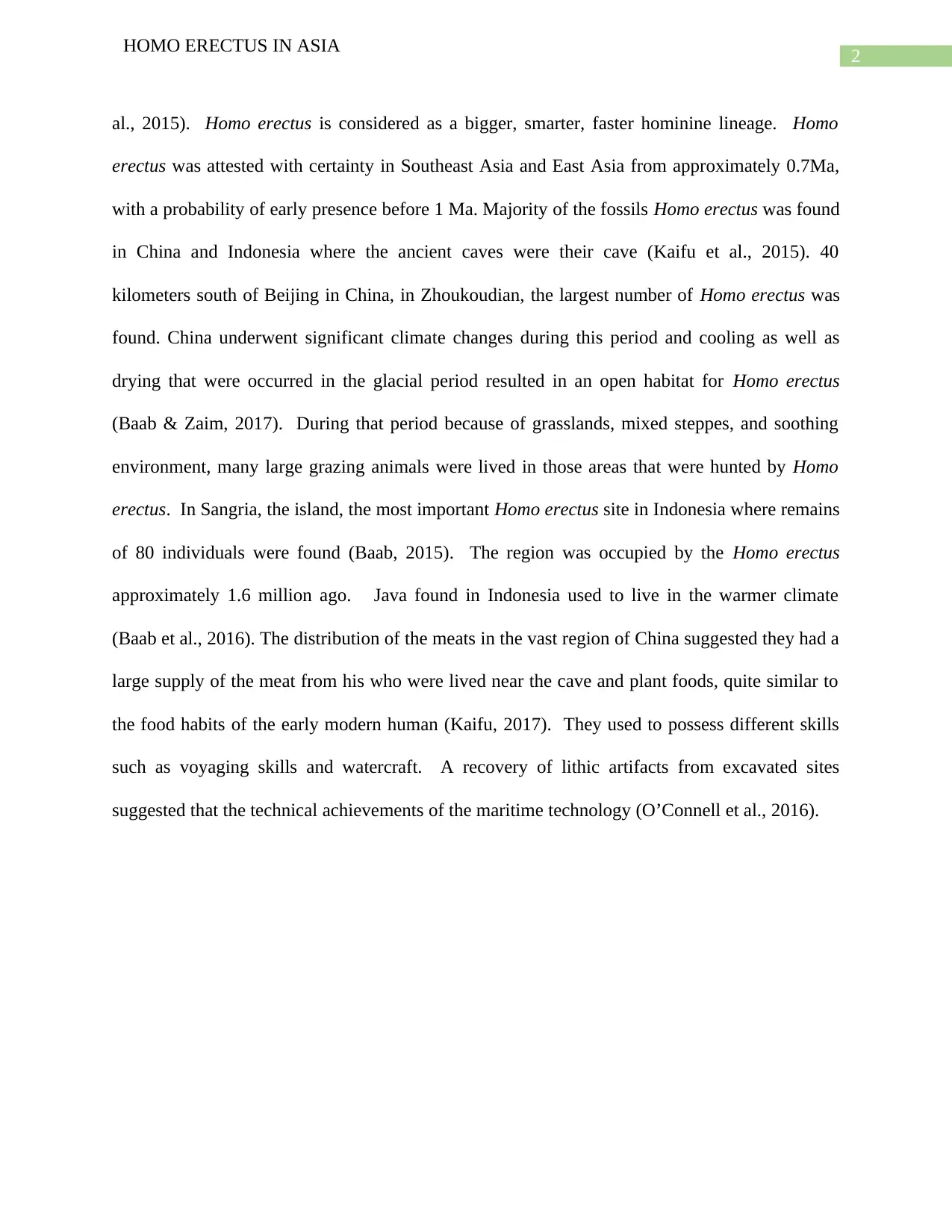
2
HOMO ERECTUS IN ASIA
al., 2015). Homo erectus is considered as a bigger, smarter, faster hominine lineage. Homo
erectus was attested with certainty in Southeast Asia and East Asia from approximately 0.7Ma,
with a probability of early presence before 1 Ma. Majority of the fossils Homo erectus was found
in China and Indonesia where the ancient caves were their cave (Kaifu et al., 2015). 40
kilometers south of Beijing in China, in Zhoukoudian, the largest number of Homo erectus was
found. China underwent significant climate changes during this period and cooling as well as
drying that were occurred in the glacial period resulted in an open habitat for Homo erectus
(Baab & Zaim, 2017). During that period because of grasslands, mixed steppes, and soothing
environment, many large grazing animals were lived in those areas that were hunted by Homo
erectus. In Sangria, the island, the most important Homo erectus site in Indonesia where remains
of 80 individuals were found (Baab, 2015). The region was occupied by the Homo erectus
approximately 1.6 million ago. Java found in Indonesia used to live in the warmer climate
(Baab et al., 2016). The distribution of the meats in the vast region of China suggested they had a
large supply of the meat from his who were lived near the cave and plant foods, quite similar to
the food habits of the early modern human (Kaifu, 2017). They used to possess different skills
such as voyaging skills and watercraft. A recovery of lithic artifacts from excavated sites
suggested that the technical achievements of the maritime technology (O’Connell et al., 2016).
HOMO ERECTUS IN ASIA
al., 2015). Homo erectus is considered as a bigger, smarter, faster hominine lineage. Homo
erectus was attested with certainty in Southeast Asia and East Asia from approximately 0.7Ma,
with a probability of early presence before 1 Ma. Majority of the fossils Homo erectus was found
in China and Indonesia where the ancient caves were their cave (Kaifu et al., 2015). 40
kilometers south of Beijing in China, in Zhoukoudian, the largest number of Homo erectus was
found. China underwent significant climate changes during this period and cooling as well as
drying that were occurred in the glacial period resulted in an open habitat for Homo erectus
(Baab & Zaim, 2017). During that period because of grasslands, mixed steppes, and soothing
environment, many large grazing animals were lived in those areas that were hunted by Homo
erectus. In Sangria, the island, the most important Homo erectus site in Indonesia where remains
of 80 individuals were found (Baab, 2015). The region was occupied by the Homo erectus
approximately 1.6 million ago. Java found in Indonesia used to live in the warmer climate
(Baab et al., 2016). The distribution of the meats in the vast region of China suggested they had a
large supply of the meat from his who were lived near the cave and plant foods, quite similar to
the food habits of the early modern human (Kaifu, 2017). They used to possess different skills
such as voyaging skills and watercraft. A recovery of lithic artifacts from excavated sites
suggested that the technical achievements of the maritime technology (O’Connell et al., 2016).
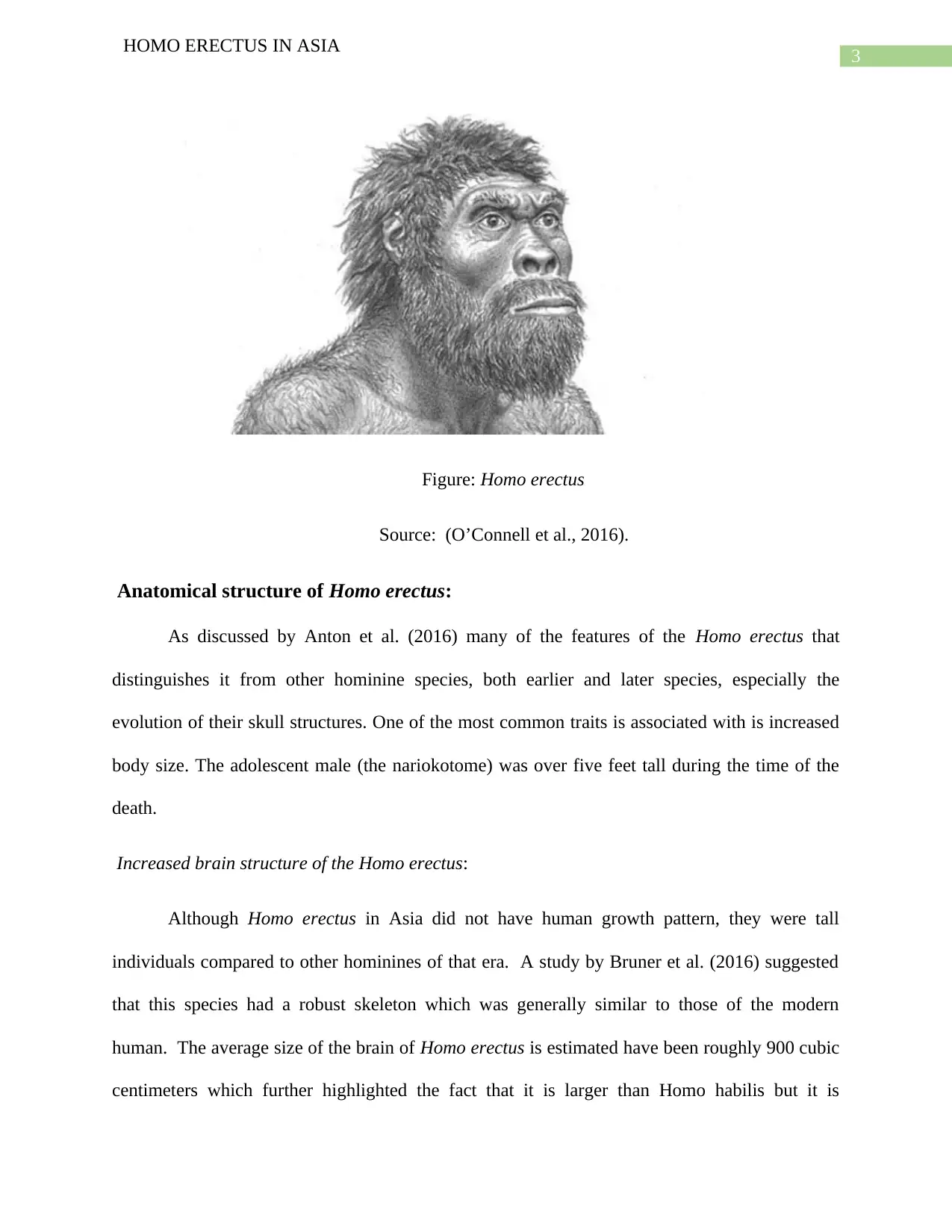
3
HOMO ERECTUS IN ASIA
Figure: Homo erectus
Source: (O’Connell et al., 2016).
Anatomical structure of Homo erectus:
As discussed by Anton et al. (2016) many of the features of the Homo erectus that
distinguishes it from other hominine species, both earlier and later species, especially the
evolution of their skull structures. One of the most common traits is associated with is increased
body size. The adolescent male (the nariokotome) was over five feet tall during the time of the
death.
Increased brain structure of the Homo erectus:
Although Homo erectus in Asia did not have human growth pattern, they were tall
individuals compared to other hominines of that era. A study by Bruner et al. (2016) suggested
that this species had a robust skeleton which was generally similar to those of the modern
human. The average size of the brain of Homo erectus is estimated have been roughly 900 cubic
centimeters which further highlighted the fact that it is larger than Homo habilis but it is
HOMO ERECTUS IN ASIA
Figure: Homo erectus
Source: (O’Connell et al., 2016).
Anatomical structure of Homo erectus:
As discussed by Anton et al. (2016) many of the features of the Homo erectus that
distinguishes it from other hominine species, both earlier and later species, especially the
evolution of their skull structures. One of the most common traits is associated with is increased
body size. The adolescent male (the nariokotome) was over five feet tall during the time of the
death.
Increased brain structure of the Homo erectus:
Although Homo erectus in Asia did not have human growth pattern, they were tall
individuals compared to other hominines of that era. A study by Bruner et al. (2016) suggested
that this species had a robust skeleton which was generally similar to those of the modern
human. The average size of the brain of Homo erectus is estimated have been roughly 900 cubic
centimeters which further highlighted the fact that it is larger than Homo habilis but it is
Secure Best Marks with AI Grader
Need help grading? Try our AI Grader for instant feedback on your assignments.
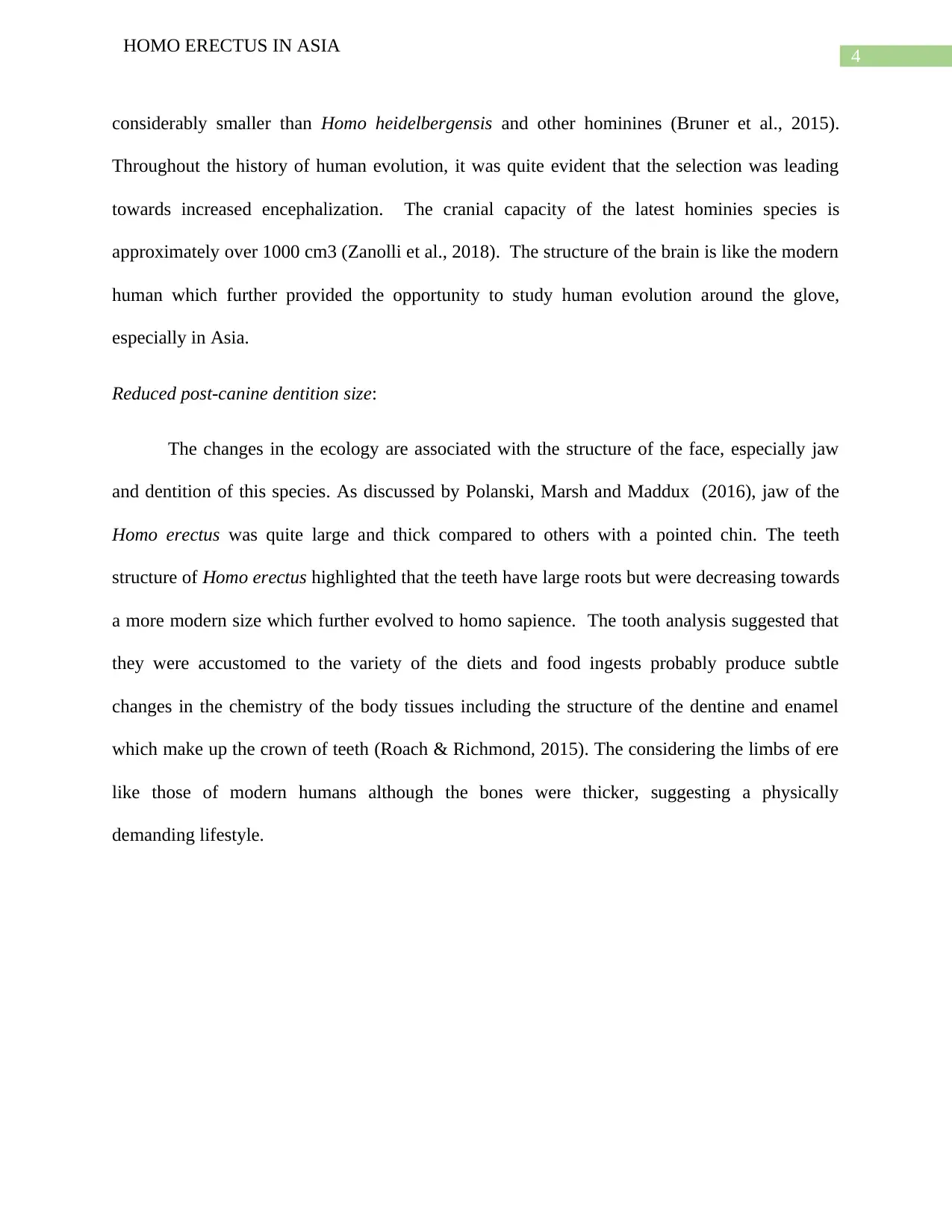
4
HOMO ERECTUS IN ASIA
considerably smaller than Homo heidelbergensis and other hominines (Bruner et al., 2015).
Throughout the history of human evolution, it was quite evident that the selection was leading
towards increased encephalization. The cranial capacity of the latest hominies species is
approximately over 1000 cm3 (Zanolli et al., 2018). The structure of the brain is like the modern
human which further provided the opportunity to study human evolution around the glove,
especially in Asia.
Reduced post-canine dentition size:
The changes in the ecology are associated with the structure of the face, especially jaw
and dentition of this species. As discussed by Polanski, Marsh and Maddux (2016), jaw of the
Homo erectus was quite large and thick compared to others with a pointed chin. The teeth
structure of Homo erectus highlighted that the teeth have large roots but were decreasing towards
a more modern size which further evolved to homo sapience. The tooth analysis suggested that
they were accustomed to the variety of the diets and food ingests probably produce subtle
changes in the chemistry of the body tissues including the structure of the dentine and enamel
which make up the crown of teeth (Roach & Richmond, 2015). The considering the limbs of ere
like those of modern humans although the bones were thicker, suggesting a physically
demanding lifestyle.
HOMO ERECTUS IN ASIA
considerably smaller than Homo heidelbergensis and other hominines (Bruner et al., 2015).
Throughout the history of human evolution, it was quite evident that the selection was leading
towards increased encephalization. The cranial capacity of the latest hominies species is
approximately over 1000 cm3 (Zanolli et al., 2018). The structure of the brain is like the modern
human which further provided the opportunity to study human evolution around the glove,
especially in Asia.
Reduced post-canine dentition size:
The changes in the ecology are associated with the structure of the face, especially jaw
and dentition of this species. As discussed by Polanski, Marsh and Maddux (2016), jaw of the
Homo erectus was quite large and thick compared to others with a pointed chin. The teeth
structure of Homo erectus highlighted that the teeth have large roots but were decreasing towards
a more modern size which further evolved to homo sapience. The tooth analysis suggested that
they were accustomed to the variety of the diets and food ingests probably produce subtle
changes in the chemistry of the body tissues including the structure of the dentine and enamel
which make up the crown of teeth (Roach & Richmond, 2015). The considering the limbs of ere
like those of modern humans although the bones were thicker, suggesting a physically
demanding lifestyle.
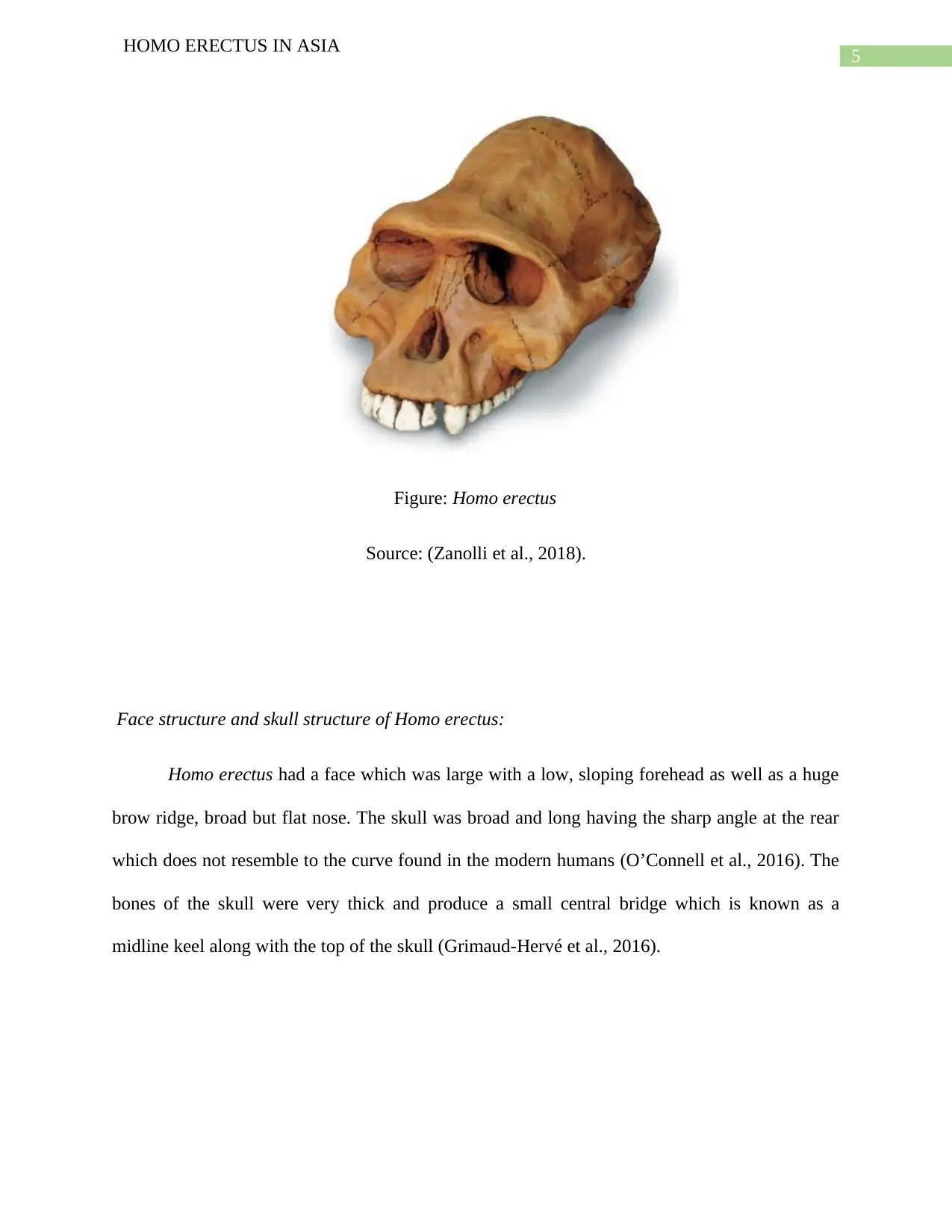
5
HOMO ERECTUS IN ASIA
Figure: Homo erectus
Source: (Zanolli et al., 2018).
Face structure and skull structure of Homo erectus:
Homo erectus had a face which was large with a low, sloping forehead as well as a huge
brow ridge, broad but flat nose. The skull was broad and long having the sharp angle at the rear
which does not resemble to the curve found in the modern humans (O’Connell et al., 2016). The
bones of the skull were very thick and produce a small central bridge which is known as a
midline keel along with the top of the skull (Grimaud-Hervé et al., 2016).
HOMO ERECTUS IN ASIA
Figure: Homo erectus
Source: (Zanolli et al., 2018).
Face structure and skull structure of Homo erectus:
Homo erectus had a face which was large with a low, sloping forehead as well as a huge
brow ridge, broad but flat nose. The skull was broad and long having the sharp angle at the rear
which does not resemble to the curve found in the modern humans (O’Connell et al., 2016). The
bones of the skull were very thick and produce a small central bridge which is known as a
midline keel along with the top of the skull (Grimaud-Hervé et al., 2016).
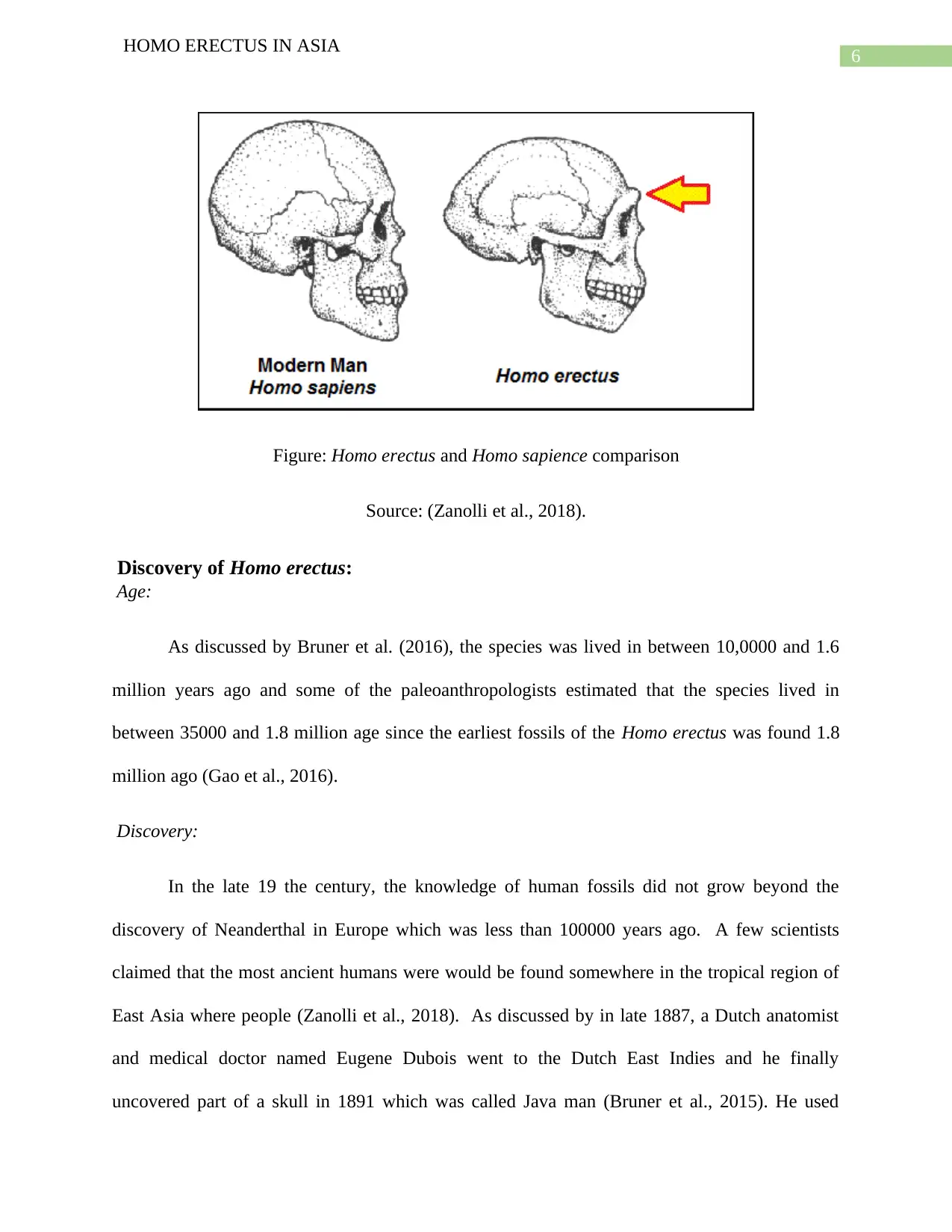
6
HOMO ERECTUS IN ASIA
Figure: Homo erectus and Homo sapience comparison
Source: (Zanolli et al., 2018).
Discovery of Homo erectus:
Age:
As discussed by Bruner et al. (2016), the species was lived in between 10,0000 and 1.6
million years ago and some of the paleoanthropologists estimated that the species lived in
between 35000 and 1.8 million age since the earliest fossils of the Homo erectus was found 1.8
million ago (Gao et al., 2016).
Discovery:
In the late 19 the century, the knowledge of human fossils did not grow beyond the
discovery of Neanderthal in Europe which was less than 100000 years ago. A few scientists
claimed that the most ancient humans were would be found somewhere in the tropical region of
East Asia where people (Zanolli et al., 2018). As discussed by in late 1887, a Dutch anatomist
and medical doctor named Eugene Dubois went to the Dutch East Indies and he finally
uncovered part of a skull in 1891 which was called Java man (Bruner et al., 2015). He used
HOMO ERECTUS IN ASIA
Figure: Homo erectus and Homo sapience comparison
Source: (Zanolli et al., 2018).
Discovery of Homo erectus:
Age:
As discussed by Bruner et al. (2016), the species was lived in between 10,0000 and 1.6
million years ago and some of the paleoanthropologists estimated that the species lived in
between 35000 and 1.8 million age since the earliest fossils of the Homo erectus was found 1.8
million ago (Gao et al., 2016).
Discovery:
In the late 19 the century, the knowledge of human fossils did not grow beyond the
discovery of Neanderthal in Europe which was less than 100000 years ago. A few scientists
claimed that the most ancient humans were would be found somewhere in the tropical region of
East Asia where people (Zanolli et al., 2018). As discussed by in late 1887, a Dutch anatomist
and medical doctor named Eugene Dubois went to the Dutch East Indies and he finally
uncovered part of a skull in 1891 which was called Java man (Bruner et al., 2015). He used
Paraphrase This Document
Need a fresh take? Get an instant paraphrase of this document with our AI Paraphraser

7
HOMO ERECTUS IN ASIA
believed that the fossils he discovered belonged to the ancient and upright man and therefore, he
coined the name Homo erectus. However, other scientists discarded the interpretations and
proposed to highlight ape like qualities of Homo erectus. Eugene Dubois’s opinion was granted
when a series of similar fossils were found in China in the period of the 1920s and 1930s. The
important specimen discoveries in Asia were the following:
• Zhoukoudian 3 which is a skullcap discovered in 1929 in Zhoukoudian of China. A study by
Bruner et al. (2016), suggested that it was an adolescent skull cap which was found in fragments.
When each fragment was fixed together it provided the idea of the young individuals with 915
cubic centimeters.
• Sangiran 2 which was a 1 million-year-old skull cap discovered in 1937 in sangria, a place
situated in Indonesia (Baab & Zaim, 2017).
• Sangiran 17 which was also a 1.2 million old skullcap discovered in sangria 1969. This skull
cap was a skullcap was of an adult male and identified as best persevered Homo erectus skull.
• Solo Man’ or Ngandong were discovered in 1932 in Ngandong, a region of Indonesia. They
shared similarities with the earlier Homo erectus from sangria and is considered to be late Homo
erectus.
• Mojokerto’ or Perning 1, which was a juvenile skull found in 1936 in mojokerto of Indonesia.
The child skull was approximately maybe as 1.8 million years.
• Zhoukoudian 5 was found in the Zhoukoudian in China. This skull was reconstructed from
the several pieces which were found in that era (Xing et al., 2016).
HOMO ERECTUS IN ASIA
believed that the fossils he discovered belonged to the ancient and upright man and therefore, he
coined the name Homo erectus. However, other scientists discarded the interpretations and
proposed to highlight ape like qualities of Homo erectus. Eugene Dubois’s opinion was granted
when a series of similar fossils were found in China in the period of the 1920s and 1930s. The
important specimen discoveries in Asia were the following:
• Zhoukoudian 3 which is a skullcap discovered in 1929 in Zhoukoudian of China. A study by
Bruner et al. (2016), suggested that it was an adolescent skull cap which was found in fragments.
When each fragment was fixed together it provided the idea of the young individuals with 915
cubic centimeters.
• Sangiran 2 which was a 1 million-year-old skull cap discovered in 1937 in sangria, a place
situated in Indonesia (Baab & Zaim, 2017).
• Sangiran 17 which was also a 1.2 million old skullcap discovered in sangria 1969. This skull
cap was a skullcap was of an adult male and identified as best persevered Homo erectus skull.
• Solo Man’ or Ngandong were discovered in 1932 in Ngandong, a region of Indonesia. They
shared similarities with the earlier Homo erectus from sangria and is considered to be late Homo
erectus.
• Mojokerto’ or Perning 1, which was a juvenile skull found in 1936 in mojokerto of Indonesia.
The child skull was approximately maybe as 1.8 million years.
• Zhoukoudian 5 was found in the Zhoukoudian in China. This skull was reconstructed from
the several pieces which were found in that era (Xing et al., 2016).
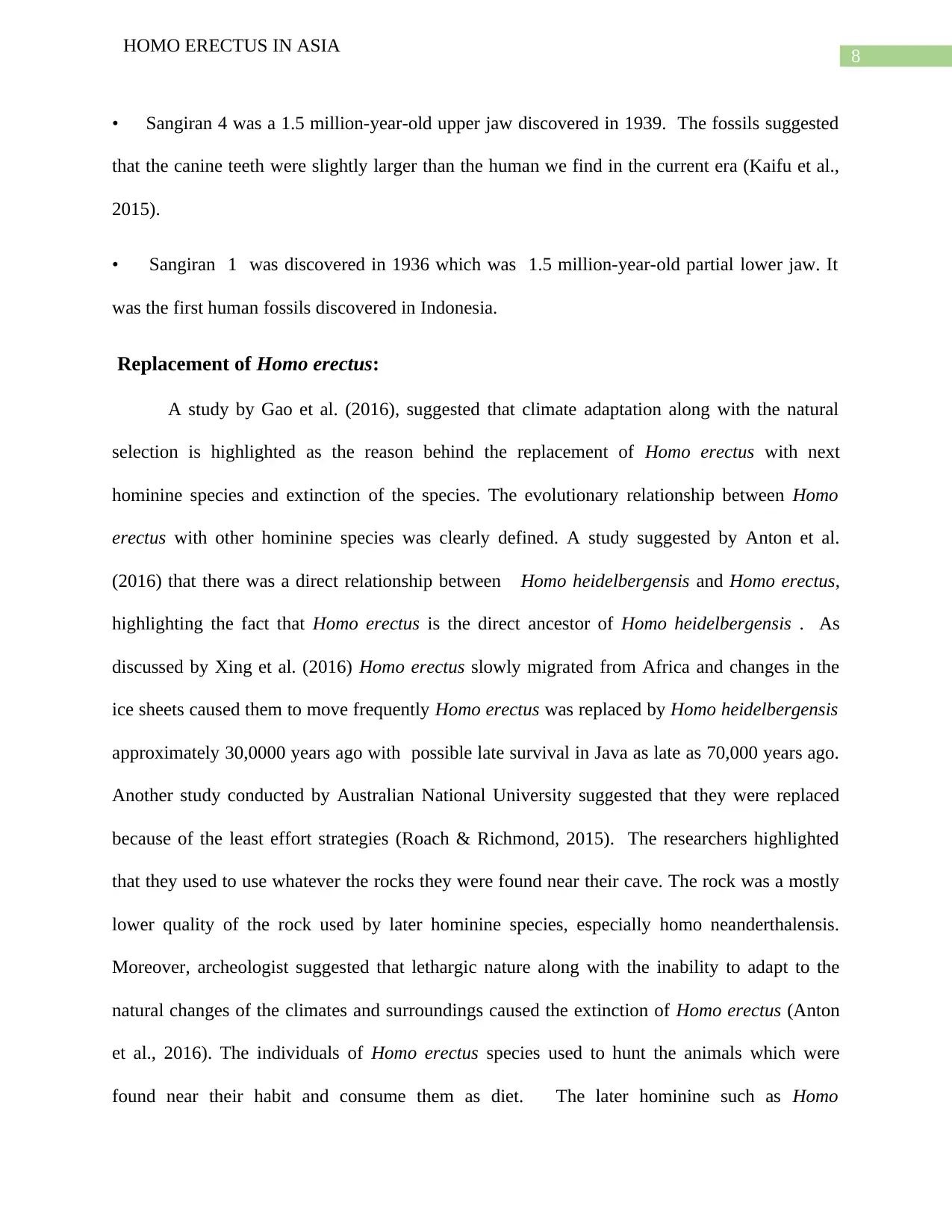
8
HOMO ERECTUS IN ASIA
• Sangiran 4 was a 1.5 million-year-old upper jaw discovered in 1939. The fossils suggested
that the canine teeth were slightly larger than the human we find in the current era (Kaifu et al.,
2015).
• Sangiran 1 was discovered in 1936 which was 1.5 million-year-old partial lower jaw. It
was the first human fossils discovered in Indonesia.
Replacement of Homo erectus:
A study by Gao et al. (2016), suggested that climate adaptation along with the natural
selection is highlighted as the reason behind the replacement of Homo erectus with next
hominine species and extinction of the species. The evolutionary relationship between Homo
erectus with other hominine species was clearly defined. A study suggested by Anton et al.
(2016) that there was a direct relationship between Homo heidelbergensis and Homo erectus,
highlighting the fact that Homo erectus is the direct ancestor of Homo heidelbergensis . As
discussed by Xing et al. (2016) Homo erectus slowly migrated from Africa and changes in the
ice sheets caused them to move frequently Homo erectus was replaced by Homo heidelbergensis
approximately 30,0000 years ago with possible late survival in Java as late as 70,000 years ago.
Another study conducted by Australian National University suggested that they were replaced
because of the least effort strategies (Roach & Richmond, 2015). The researchers highlighted
that they used to use whatever the rocks they were found near their cave. The rock was a mostly
lower quality of the rock used by later hominine species, especially homo neanderthalensis.
Moreover, archeologist suggested that lethargic nature along with the inability to adapt to the
natural changes of the climates and surroundings caused the extinction of Homo erectus (Anton
et al., 2016). The individuals of Homo erectus species used to hunt the animals which were
found near their habit and consume them as diet. The later hominine such as Homo
HOMO ERECTUS IN ASIA
• Sangiran 4 was a 1.5 million-year-old upper jaw discovered in 1939. The fossils suggested
that the canine teeth were slightly larger than the human we find in the current era (Kaifu et al.,
2015).
• Sangiran 1 was discovered in 1936 which was 1.5 million-year-old partial lower jaw. It
was the first human fossils discovered in Indonesia.
Replacement of Homo erectus:
A study by Gao et al. (2016), suggested that climate adaptation along with the natural
selection is highlighted as the reason behind the replacement of Homo erectus with next
hominine species and extinction of the species. The evolutionary relationship between Homo
erectus with other hominine species was clearly defined. A study suggested by Anton et al.
(2016) that there was a direct relationship between Homo heidelbergensis and Homo erectus,
highlighting the fact that Homo erectus is the direct ancestor of Homo heidelbergensis . As
discussed by Xing et al. (2016) Homo erectus slowly migrated from Africa and changes in the
ice sheets caused them to move frequently Homo erectus was replaced by Homo heidelbergensis
approximately 30,0000 years ago with possible late survival in Java as late as 70,000 years ago.
Another study conducted by Australian National University suggested that they were replaced
because of the least effort strategies (Roach & Richmond, 2015). The researchers highlighted
that they used to use whatever the rocks they were found near their cave. The rock was a mostly
lower quality of the rock used by later hominine species, especially homo neanderthalensis.
Moreover, archeologist suggested that lethargic nature along with the inability to adapt to the
natural changes of the climates and surroundings caused the extinction of Homo erectus (Anton
et al., 2016). The individuals of Homo erectus species used to hunt the animals which were
found near their habit and consume them as diet. The later hominine such as Homo

9
HOMO ERECTUS IN ASIA
heidelbergensis and Homo neanderthalensis had the much-advanced capability of the using
strategies to use the rock for the tool. The later hominines, especially Homo neanderthalensis
used to climb mountains to collect rock suitable for the stone tool highlighted the unique
strategies to adapt to the surroundings and climate. Moreover, to consume a suitable diet they
used to walk the long distance to hunt animals which highlighted their advanced cognitive
development. Homo heidelbergensis had the typical cranial volume of approximately 1,250 cm3
whereas homo neanderthalensis had the typical cranial volume of approximately 1350 cubic
centimeters (Zhuo et al., 2016) .
Conclusion:
Thus it can be concluded that Homo erectus is a species of archaic human be found in
Asia and displayed many anatomical features which reflect the evolution towards homo sapience
over the decades. Homo erectus is considered as A Bigger, Smarter, and Faster Hominine
Lineage. Majority of the fossils Homo erectus was found in China and Indonesia where the
ancient caves were their cave. In Sangria, the island of Java, the most important Homo erectus
site in Indonesia where remains of 80 individuals were found whereas 40 kilometers south of
Beijing in China, in Zhoukoudian, the largest number of Homo erectus was found. The earliest
fossils of the Homo erectus were found 1.8 million ago. In 1891, Eugene Dubois finally
uncovered part of a skull in 1891 and coined the term homo, Erectus. The average size of the
brain of Homo erectus is estimated have been roughly 900 cubics and had a face which was large
with a low, sloping forehead as well as a huge brow ridge, broad but flat nose. However,
archeologist suggested that lethargic nature along with the inability to adapt to the natural
changes of the climates and surroundings caused the extinction of Homo erectus.
HOMO ERECTUS IN ASIA
heidelbergensis and Homo neanderthalensis had the much-advanced capability of the using
strategies to use the rock for the tool. The later hominines, especially Homo neanderthalensis
used to climb mountains to collect rock suitable for the stone tool highlighted the unique
strategies to adapt to the surroundings and climate. Moreover, to consume a suitable diet they
used to walk the long distance to hunt animals which highlighted their advanced cognitive
development. Homo heidelbergensis had the typical cranial volume of approximately 1,250 cm3
whereas homo neanderthalensis had the typical cranial volume of approximately 1350 cubic
centimeters (Zhuo et al., 2016) .
Conclusion:
Thus it can be concluded that Homo erectus is a species of archaic human be found in
Asia and displayed many anatomical features which reflect the evolution towards homo sapience
over the decades. Homo erectus is considered as A Bigger, Smarter, and Faster Hominine
Lineage. Majority of the fossils Homo erectus was found in China and Indonesia where the
ancient caves were their cave. In Sangria, the island of Java, the most important Homo erectus
site in Indonesia where remains of 80 individuals were found whereas 40 kilometers south of
Beijing in China, in Zhoukoudian, the largest number of Homo erectus was found. The earliest
fossils of the Homo erectus were found 1.8 million ago. In 1891, Eugene Dubois finally
uncovered part of a skull in 1891 and coined the term homo, Erectus. The average size of the
brain of Homo erectus is estimated have been roughly 900 cubics and had a face which was large
with a low, sloping forehead as well as a huge brow ridge, broad but flat nose. However,
archeologist suggested that lethargic nature along with the inability to adapt to the natural
changes of the climates and surroundings caused the extinction of Homo erectus.
Secure Best Marks with AI Grader
Need help grading? Try our AI Grader for instant feedback on your assignments.

10
HOMO ERECTUS IN ASIA
HOMO ERECTUS IN ASIA

11
HOMO ERECTUS IN ASIA
References:
Anton, S. C., Taboada, H. G., Middleton, E. R., Rainwater, C. W., Taylor, A. B., Turner, T.
R., ... & Williams, S. A. (2016). Morphological variation in Homo erectus and the origins
of developmental plasticity. Philosophical Transactions of the Royal Society B:
Biological Sciences, 371(1698), 20150236.. Retrieved from:
https://royalsocietypublishing.org/doi/full/10.1098/rstb.2015.0236
Baab, K. L. (2015). Defining Homo erectus. Handbook of paleoanthropology, 2189-
2219.Retrived from: https://link.springer.com/referenceworkentry/10.1007%2F978-3-
642-39979-4_73
Baab, K. L. (2016). The role of neurocranial shape in defining the boundaries of an expanded
Homo erectus hypodigm. Journal of human evolution, 92, 1-21. Retrieved from:
http://pages.nycep.org/ed/download/pdf/NMG%2094.pdf
Baab, K. L., & Zaim, Y. (2017). Global and local perspectives on cranial shape variation in
Indonesian Homo erectus. Anthropological Science, 170413. Retrieved from:
https://www.jstage.jst.go.jp/article/ase/advpub/0/advpub_170413/_pdf
Baab, K. L., Brown, P., Falk, D., Richtsmeier, J. T., Hildebolt, C. F., Smith, K., & Jungers, W.
(2016). A critical evaluation of the Down syndrome diagnosis for LB1, type specimen of
Homo floresiensis. PloS one, 11(6), e0155731. Retrieved from:
https://journals.plos.org/plosone/article?id=10.1371/journal.pone.0155731
HOMO ERECTUS IN ASIA
References:
Anton, S. C., Taboada, H. G., Middleton, E. R., Rainwater, C. W., Taylor, A. B., Turner, T.
R., ... & Williams, S. A. (2016). Morphological variation in Homo erectus and the origins
of developmental plasticity. Philosophical Transactions of the Royal Society B:
Biological Sciences, 371(1698), 20150236.. Retrieved from:
https://royalsocietypublishing.org/doi/full/10.1098/rstb.2015.0236
Baab, K. L. (2015). Defining Homo erectus. Handbook of paleoanthropology, 2189-
2219.Retrived from: https://link.springer.com/referenceworkentry/10.1007%2F978-3-
642-39979-4_73
Baab, K. L. (2016). The role of neurocranial shape in defining the boundaries of an expanded
Homo erectus hypodigm. Journal of human evolution, 92, 1-21. Retrieved from:
http://pages.nycep.org/ed/download/pdf/NMG%2094.pdf
Baab, K. L., & Zaim, Y. (2017). Global and local perspectives on cranial shape variation in
Indonesian Homo erectus. Anthropological Science, 170413. Retrieved from:
https://www.jstage.jst.go.jp/article/ase/advpub/0/advpub_170413/_pdf
Baab, K. L., Brown, P., Falk, D., Richtsmeier, J. T., Hildebolt, C. F., Smith, K., & Jungers, W.
(2016). A critical evaluation of the Down syndrome diagnosis for LB1, type specimen of
Homo floresiensis. PloS one, 11(6), e0155731. Retrieved from:
https://journals.plos.org/plosone/article?id=10.1371/journal.pone.0155731
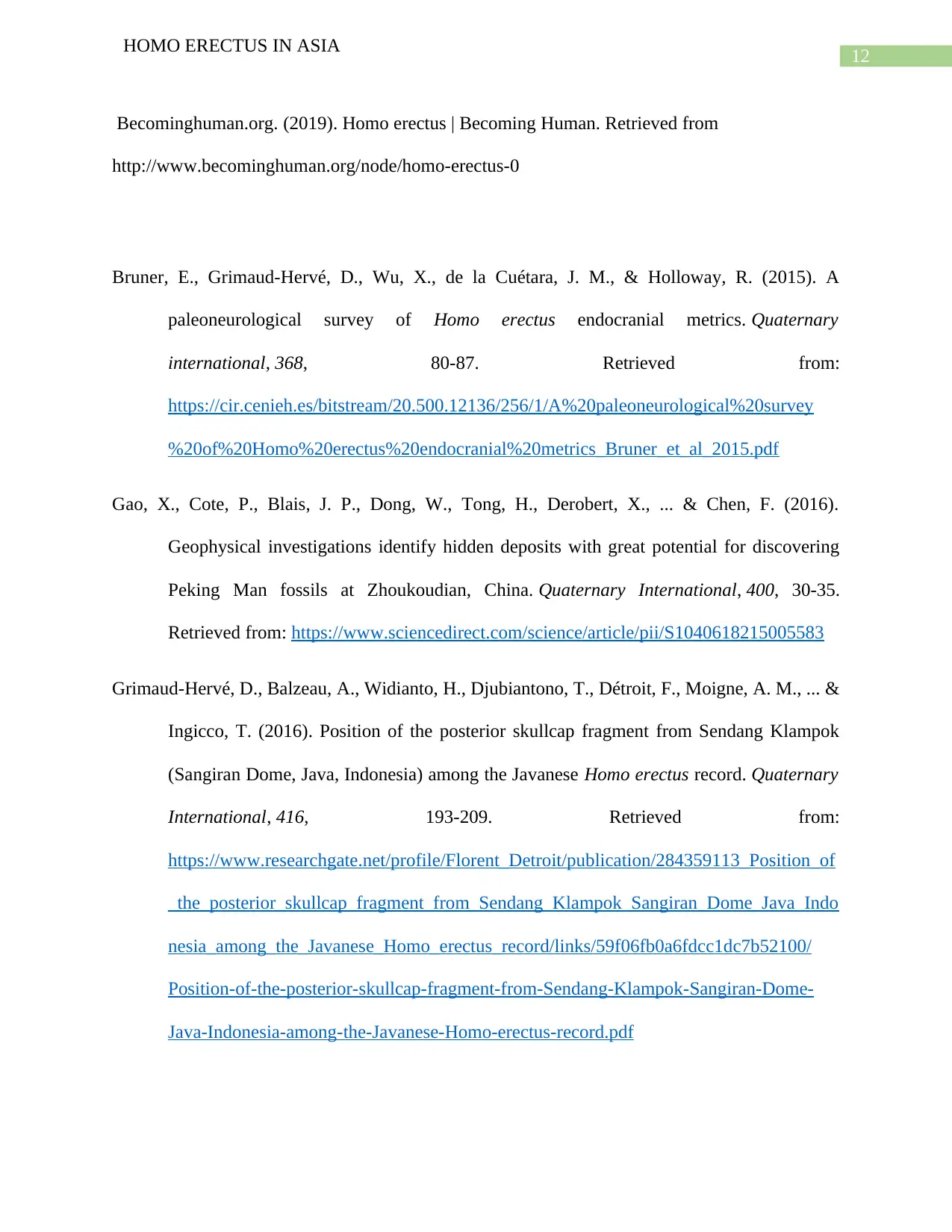
12
HOMO ERECTUS IN ASIA
Becominghuman.org. (2019). Homo erectus | Becoming Human. Retrieved from
http://www.becominghuman.org/node/homo-erectus-0
Bruner, E., Grimaud-Hervé, D., Wu, X., de la Cuétara, J. M., & Holloway, R. (2015). A
paleoneurological survey of Homo erectus endocranial metrics. Quaternary
international, 368, 80-87. Retrieved from:
https://cir.cenieh.es/bitstream/20.500.12136/256/1/A%20paleoneurological%20survey
%20of%20Homo%20erectus%20endocranial%20metrics_Bruner_et_al_2015.pdf
Gao, X., Cote, P., Blais, J. P., Dong, W., Tong, H., Derobert, X., ... & Chen, F. (2016).
Geophysical investigations identify hidden deposits with great potential for discovering
Peking Man fossils at Zhoukoudian, China. Quaternary International, 400, 30-35.
Retrieved from: https://www.sciencedirect.com/science/article/pii/S1040618215005583
Grimaud-Hervé, D., Balzeau, A., Widianto, H., Djubiantono, T., Détroit, F., Moigne, A. M., ... &
Ingicco, T. (2016). Position of the posterior skullcap fragment from Sendang Klampok
(Sangiran Dome, Java, Indonesia) among the Javanese Homo erectus record. Quaternary
International, 416, 193-209. Retrieved from:
https://www.researchgate.net/profile/Florent_Detroit/publication/284359113_Position_of
_the_posterior_skullcap_fragment_from_Sendang_Klampok_Sangiran_Dome_Java_Indo
nesia_among_the_Javanese_Homo_erectus_record/links/59f06fb0a6fdcc1dc7b52100/
Position-of-the-posterior-skullcap-fragment-from-Sendang-Klampok-Sangiran-Dome-
Java-Indonesia-among-the-Javanese-Homo-erectus-record.pdf
HOMO ERECTUS IN ASIA
Becominghuman.org. (2019). Homo erectus | Becoming Human. Retrieved from
http://www.becominghuman.org/node/homo-erectus-0
Bruner, E., Grimaud-Hervé, D., Wu, X., de la Cuétara, J. M., & Holloway, R. (2015). A
paleoneurological survey of Homo erectus endocranial metrics. Quaternary
international, 368, 80-87. Retrieved from:
https://cir.cenieh.es/bitstream/20.500.12136/256/1/A%20paleoneurological%20survey
%20of%20Homo%20erectus%20endocranial%20metrics_Bruner_et_al_2015.pdf
Gao, X., Cote, P., Blais, J. P., Dong, W., Tong, H., Derobert, X., ... & Chen, F. (2016).
Geophysical investigations identify hidden deposits with great potential for discovering
Peking Man fossils at Zhoukoudian, China. Quaternary International, 400, 30-35.
Retrieved from: https://www.sciencedirect.com/science/article/pii/S1040618215005583
Grimaud-Hervé, D., Balzeau, A., Widianto, H., Djubiantono, T., Détroit, F., Moigne, A. M., ... &
Ingicco, T. (2016). Position of the posterior skullcap fragment from Sendang Klampok
(Sangiran Dome, Java, Indonesia) among the Javanese Homo erectus record. Quaternary
International, 416, 193-209. Retrieved from:
https://www.researchgate.net/profile/Florent_Detroit/publication/284359113_Position_of
_the_posterior_skullcap_fragment_from_Sendang_Klampok_Sangiran_Dome_Java_Indo
nesia_among_the_Javanese_Homo_erectus_record/links/59f06fb0a6fdcc1dc7b52100/
Position-of-the-posterior-skullcap-fragment-from-Sendang-Klampok-Sangiran-Dome-
Java-Indonesia-among-the-Javanese-Homo-erectus-record.pdf
Paraphrase This Document
Need a fresh take? Get an instant paraphrase of this document with our AI Paraphraser
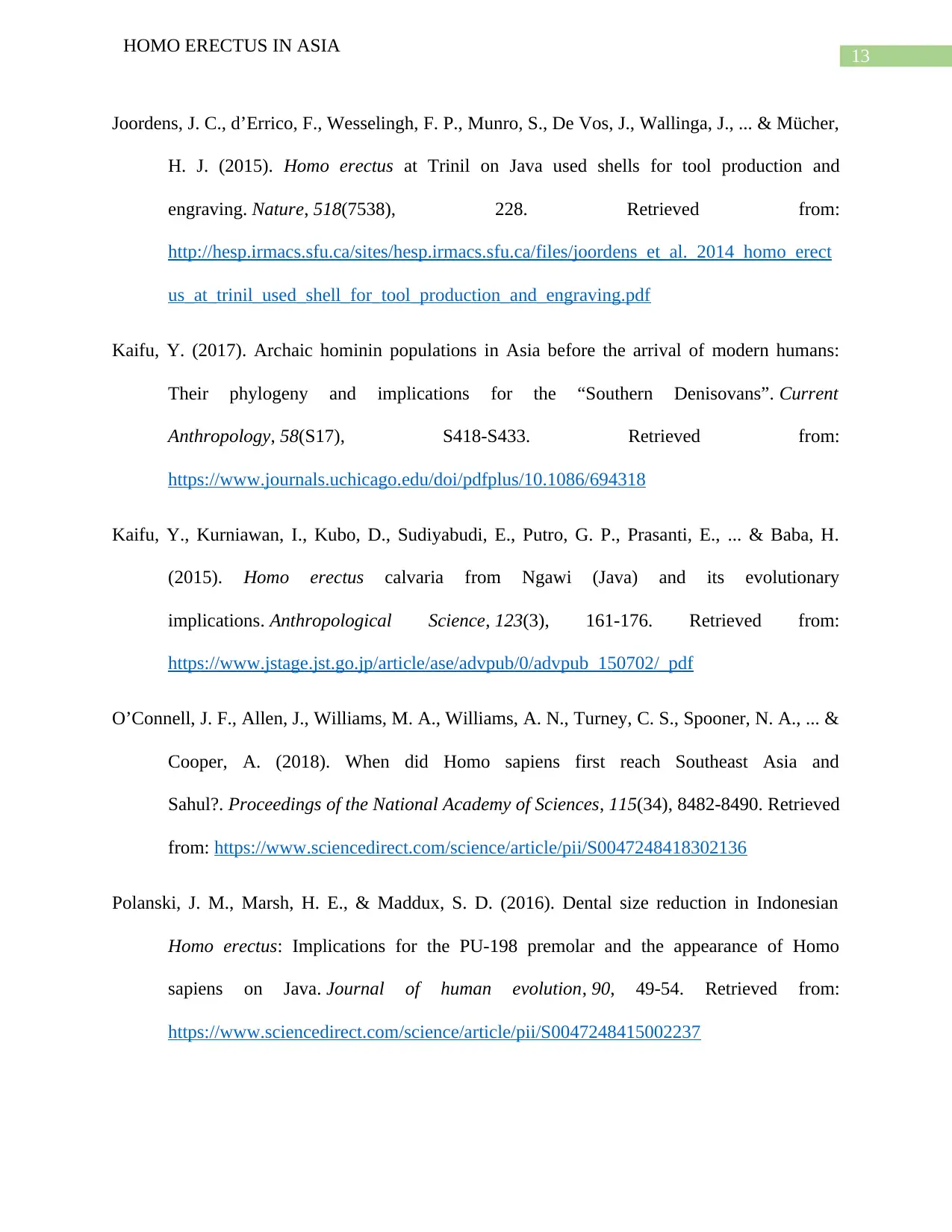
13
HOMO ERECTUS IN ASIA
Joordens, J. C., d’Errico, F., Wesselingh, F. P., Munro, S., De Vos, J., Wallinga, J., ... & Mücher,
H. J. (2015). Homo erectus at Trinil on Java used shells for tool production and
engraving. Nature, 518(7538), 228. Retrieved from:
http://hesp.irmacs.sfu.ca/sites/hesp.irmacs.sfu.ca/files/joordens_et_al._2014_homo_erect
us_at_trinil_used_shell_for_tool_production_and_engraving.pdf
Kaifu, Y. (2017). Archaic hominin populations in Asia before the arrival of modern humans:
Their phylogeny and implications for the “Southern Denisovans”. Current
Anthropology, 58(S17), S418-S433. Retrieved from:
https://www.journals.uchicago.edu/doi/pdfplus/10.1086/694318
Kaifu, Y., Kurniawan, I., Kubo, D., Sudiyabudi, E., Putro, G. P., Prasanti, E., ... & Baba, H.
(2015). Homo erectus calvaria from Ngawi (Java) and its evolutionary
implications. Anthropological Science, 123(3), 161-176. Retrieved from:
https://www.jstage.jst.go.jp/article/ase/advpub/0/advpub_150702/_pdf
O’Connell, J. F., Allen, J., Williams, M. A., Williams, A. N., Turney, C. S., Spooner, N. A., ... &
Cooper, A. (2018). When did Homo sapiens first reach Southeast Asia and
Sahul?. Proceedings of the National Academy of Sciences, 115(34), 8482-8490. Retrieved
from: https://www.sciencedirect.com/science/article/pii/S0047248418302136
Polanski, J. M., Marsh, H. E., & Maddux, S. D. (2016). Dental size reduction in Indonesian
Homo erectus: Implications for the PU-198 premolar and the appearance of Homo
sapiens on Java. Journal of human evolution, 90, 49-54. Retrieved from:
https://www.sciencedirect.com/science/article/pii/S0047248415002237
HOMO ERECTUS IN ASIA
Joordens, J. C., d’Errico, F., Wesselingh, F. P., Munro, S., De Vos, J., Wallinga, J., ... & Mücher,
H. J. (2015). Homo erectus at Trinil on Java used shells for tool production and
engraving. Nature, 518(7538), 228. Retrieved from:
http://hesp.irmacs.sfu.ca/sites/hesp.irmacs.sfu.ca/files/joordens_et_al._2014_homo_erect
us_at_trinil_used_shell_for_tool_production_and_engraving.pdf
Kaifu, Y. (2017). Archaic hominin populations in Asia before the arrival of modern humans:
Their phylogeny and implications for the “Southern Denisovans”. Current
Anthropology, 58(S17), S418-S433. Retrieved from:
https://www.journals.uchicago.edu/doi/pdfplus/10.1086/694318
Kaifu, Y., Kurniawan, I., Kubo, D., Sudiyabudi, E., Putro, G. P., Prasanti, E., ... & Baba, H.
(2015). Homo erectus calvaria from Ngawi (Java) and its evolutionary
implications. Anthropological Science, 123(3), 161-176. Retrieved from:
https://www.jstage.jst.go.jp/article/ase/advpub/0/advpub_150702/_pdf
O’Connell, J. F., Allen, J., Williams, M. A., Williams, A. N., Turney, C. S., Spooner, N. A., ... &
Cooper, A. (2018). When did Homo sapiens first reach Southeast Asia and
Sahul?. Proceedings of the National Academy of Sciences, 115(34), 8482-8490. Retrieved
from: https://www.sciencedirect.com/science/article/pii/S0047248418302136
Polanski, J. M., Marsh, H. E., & Maddux, S. D. (2016). Dental size reduction in Indonesian
Homo erectus: Implications for the PU-198 premolar and the appearance of Homo
sapiens on Java. Journal of human evolution, 90, 49-54. Retrieved from:
https://www.sciencedirect.com/science/article/pii/S0047248415002237
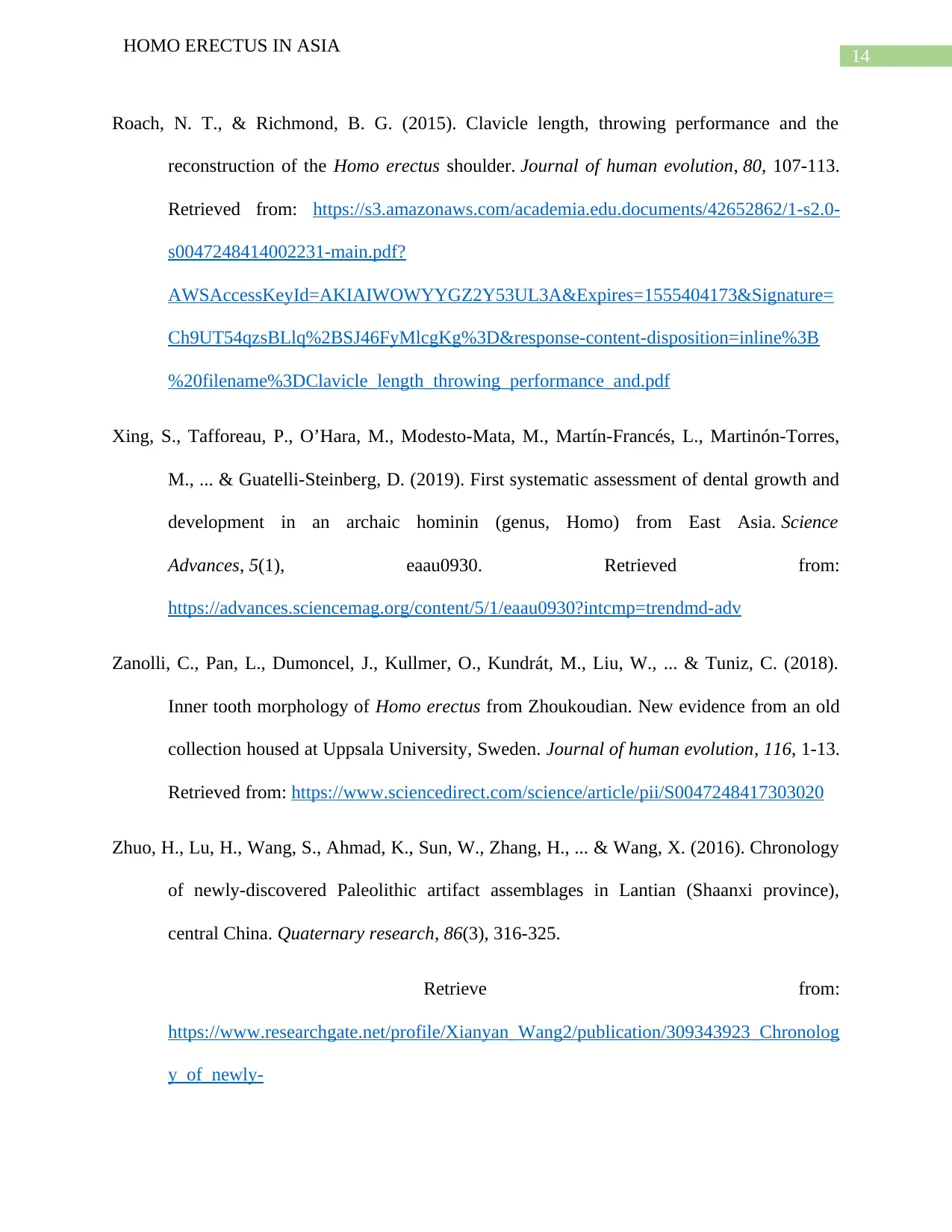
14
HOMO ERECTUS IN ASIA
Roach, N. T., & Richmond, B. G. (2015). Clavicle length, throwing performance and the
reconstruction of the Homo erectus shoulder. Journal of human evolution, 80, 107-113.
Retrieved from: https://s3.amazonaws.com/academia.edu.documents/42652862/1-s2.0-
s0047248414002231-main.pdf?
AWSAccessKeyId=AKIAIWOWYYGZ2Y53UL3A&Expires=1555404173&Signature=
Ch9UT54qzsBLlq%2BSJ46FyMlcgKg%3D&response-content-disposition=inline%3B
%20filename%3DClavicle_length_throwing_performance_and.pdf
Xing, S., Tafforeau, P., O’Hara, M., Modesto-Mata, M., Martín-Francés, L., Martinón-Torres,
M., ... & Guatelli-Steinberg, D. (2019). First systematic assessment of dental growth and
development in an archaic hominin (genus, Homo) from East Asia. Science
Advances, 5(1), eaau0930. Retrieved from:
https://advances.sciencemag.org/content/5/1/eaau0930?intcmp=trendmd-adv
Zanolli, C., Pan, L., Dumoncel, J., Kullmer, O., Kundrát, M., Liu, W., ... & Tuniz, C. (2018).
Inner tooth morphology of Homo erectus from Zhoukoudian. New evidence from an old
collection housed at Uppsala University, Sweden. Journal of human evolution, 116, 1-13.
Retrieved from: https://www.sciencedirect.com/science/article/pii/S0047248417303020
Zhuo, H., Lu, H., Wang, S., Ahmad, K., Sun, W., Zhang, H., ... & Wang, X. (2016). Chronology
of newly-discovered Paleolithic artifact assemblages in Lantian (Shaanxi province),
central China. Quaternary research, 86(3), 316-325.
Retrieve from:
https://www.researchgate.net/profile/Xianyan_Wang2/publication/309343923_Chronolog
y_of_newly-
HOMO ERECTUS IN ASIA
Roach, N. T., & Richmond, B. G. (2015). Clavicle length, throwing performance and the
reconstruction of the Homo erectus shoulder. Journal of human evolution, 80, 107-113.
Retrieved from: https://s3.amazonaws.com/academia.edu.documents/42652862/1-s2.0-
s0047248414002231-main.pdf?
AWSAccessKeyId=AKIAIWOWYYGZ2Y53UL3A&Expires=1555404173&Signature=
Ch9UT54qzsBLlq%2BSJ46FyMlcgKg%3D&response-content-disposition=inline%3B
%20filename%3DClavicle_length_throwing_performance_and.pdf
Xing, S., Tafforeau, P., O’Hara, M., Modesto-Mata, M., Martín-Francés, L., Martinón-Torres,
M., ... & Guatelli-Steinberg, D. (2019). First systematic assessment of dental growth and
development in an archaic hominin (genus, Homo) from East Asia. Science
Advances, 5(1), eaau0930. Retrieved from:
https://advances.sciencemag.org/content/5/1/eaau0930?intcmp=trendmd-adv
Zanolli, C., Pan, L., Dumoncel, J., Kullmer, O., Kundrát, M., Liu, W., ... & Tuniz, C. (2018).
Inner tooth morphology of Homo erectus from Zhoukoudian. New evidence from an old
collection housed at Uppsala University, Sweden. Journal of human evolution, 116, 1-13.
Retrieved from: https://www.sciencedirect.com/science/article/pii/S0047248417303020
Zhuo, H., Lu, H., Wang, S., Ahmad, K., Sun, W., Zhang, H., ... & Wang, X. (2016). Chronology
of newly-discovered Paleolithic artifact assemblages in Lantian (Shaanxi province),
central China. Quaternary research, 86(3), 316-325.
Retrieve from:
https://www.researchgate.net/profile/Xianyan_Wang2/publication/309343923_Chronolog
y_of_newly-

15
HOMO ERECTUS IN ASIA
discovered_Paleolithic_artifact_assemblages_in_Lantian_Shaanxi_province_central_Chi
na/links/5b16554c0f7e9bda0ffe74de/Chronology-of-newly-discovered-Paleolithic-
artifact-assemblages-in-Lantian-Shaanxi-province-central-China.pdf
HOMO ERECTUS IN ASIA
discovered_Paleolithic_artifact_assemblages_in_Lantian_Shaanxi_province_central_Chi
na/links/5b16554c0f7e9bda0ffe74de/Chronology-of-newly-discovered-Paleolithic-
artifact-assemblages-in-Lantian-Shaanxi-province-central-China.pdf
1 out of 16
Related Documents
Your All-in-One AI-Powered Toolkit for Academic Success.
+13062052269
info@desklib.com
Available 24*7 on WhatsApp / Email
![[object Object]](/_next/static/media/star-bottom.7253800d.svg)
Unlock your academic potential
© 2024 | Zucol Services PVT LTD | All rights reserved.



